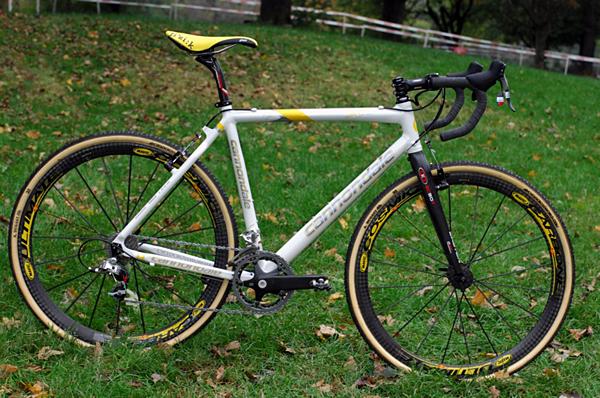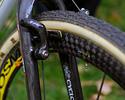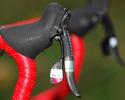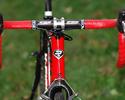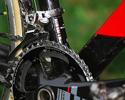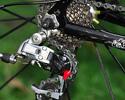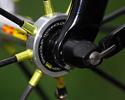
Recently on Cyclingnews.com |
Pro Bike, December 10, 2007
Tim Johnson's Cannondale-Leer-Cyclocrossworld.com Cannondale XTJ & Lyne Bessette's Cyclocrossworld.com Ridley X-Fire
Same, but differentBy James Huang Just as in the world of auto racing, one umbrella sponsor can support several teams of different names. In the world of cyclo-cross, online retailer and news portal Cyclocrossworld.com is that umbrella with its sponsorship of the Cannondale-Leer-Cyclocrossworld.com team of Tim Johnson and the Cyclocrossworld.com squad of Lyne Bessette and Jeremy Powers. Johnson competes aboard his own signature bike, the Cannondale XTJ, while Bessette and Powers both utilize Ridley's latest 'cross creation, the X-Fire. Ridley slots the X-Fire in between its already successful carbon fiber X-Night and aluminum/carbon Supercross frames, and doesn't appear to have skimped much on the performance. The smooth, organic lines of the X-Fire stands in sharp contrast to the 'Sharp Edge Design' that characterizes its bigger brother (and the road going Noah), but its monocoque carbon fiber construction still tips the scales at a competitive 1.32kg. Ridley's own 4ZA monocoque carbon 'cross fork completes the front end. The X-Fire also boasts a revised geometry relative to the Euro-classic numbers of the X-Night. "Ridley's done a really nice job of rethinking the geometry on the 'cross bikes, and that particular bike has been very successful," said Stu Thorne of Cyclocrossworld.com. "It's extremely light and it rides well. The biggest change is the lower bottom bracket. It's about a centimeter lower than their other bikes, enough to feel a difference. They call their other bikes 'European bikes' with the higher bottom bracket, and they really work well for a lot of people. But a lower bottom bracket in this country is a little more acceptable. I like it a little bit higher because you can pedal through the turns without the risk of catching a pedal or crankarm. You can get on a gas a little bit earlier. Even the X-Fire is a little higher than normal, but not as high as some of the other models they sell." Johnson's Cannondale XTJ, on the other hand, sticks with the company's bread and butter material and its latest CAAD9 (Cannondale Advanced Aluminum Design) architecture. Although there's no carbon fiber to be seen anywhere in the frame, the aggressive tube shaping and butting of the Optimo aluminum alloy (said to be 15% stronger than 6061-T6) keeps it competitive on the 'cross circuit. A conical down tube and seat tube keep things stiff at the bottom bracket, while a Johnson-requested swaged top tube reportedly delivers outstanding torsional rigidity without adding weight. The thin hourglass seat stays stand in stark contrast to the oversized tubing used elsewhere, but provide a comfortable ride out back without softening things up too much. A similar ride quality is provided up front by the Easton EC90X monocoque carbon fork. Cannondale arguably gets a firm leg up on its competition with the XTJ's integrated BB30 bottom bracket and crankset design, though, which is said to save significant amounts of weight while actually offering a stiffer pedaling platform. Cannondale has championed its proprietary system for years and only recently has decided to open up the standard for use by other companies such as Specialized and Van Dessel. Otherwise, both teams utilize largely identical build kits that include SRAM Red groups, TRP CR950 carbon cantilever brakes, fi'zi:k saddles and handlebar tape, SwissStop brake pads, and FSA stems, bars, and seatposts. For wheelsets, the teams run exclusively on Mavic's new R-SYS tubular wheels and the company's ultra-pimpy Cosmic Carbone Ultimate, both wrapped in Dugast tubulars. "They are, by far, the most supple tires out there," said Thorne of the Dugast tires. "You run them at low pressures like any other tubular, but they just handle that much better because the casing is so supple. They conform to the terrain better so you're always getting a good contact patch, the tread's always engaged with the terrain, and they're light. We use [the Typhoons] about 75% of the time, and we use the Rhinos exclusively when it's muddy." That mud came in waves during the first weekend of December at the USGP race in Portland, Oregon where Johnson took the second step of podium (Bessette unfortunately abandoned after crashing into a deep section of ice cold water). Other than the swap to the more aggressive Rhino tread, though, both Johnson's and Bessette's bikes bore little change from what they had been running all season. "The bikes are completely overhauled often, and we changed out all the cables before Portland, but [there were] no other special tricks for that one," said Thorne, who also acts as the teams' regular support crew throughout the season in addition as the main sponsor. "Tire pressure is the only thing we change often and get pretty critical with. We have some benchmarks that we'll start out, and the rider will make a decision based on the course and conditions. It doesn't fluctuate that much, but I'd say Tim fluctuates the most with his pressures: anywhere from 26 to about 32psi, depending on the course. I'll usually set his bike up at a benchmark of 30psi and he'll go out and do a few hot laps or ride a couple of sections pretty hard and come back with some feedback and we'll make tire pressure adjustments based on that. Sometimes it's just a psi. Lyne, being the Canadian, we run everything in BAR; we'll run everything from 1.7bar to 1.85bar, or about 24psi." In some ways, the Portland race was a typical example of how each rider's season has gone so far. Johnson started out slowly and gradually picked up momentum throughout, while Bessette has unfortunately been hit with several illnesses. "[Tim] came off the road immediately before Vegas," said Thorne. "The training for road is just so different from the training for 'cross, so he still had the big road miles on. He really didn't have the snap and it showed in Las Vegas. He knew it, though, and he wasn't upset about it. He was a little bummed out, but he understood why he finished ninth or something, and as the season progressed, he really worked himself into 'cross form and I think he's really going pretty well and his season is right on par." "Lyne started out strong but has had various bouts of illness, the flu, sinus infection, and stuff like that and it's affected her overall season," he continued. "She's still had a pretty good year and she won a few UCI races. Unfortunately she got sick just before the Canadian nationals and that really set her back. She's been struggling with that since then, but overall, not a bad season." Even with both riders' ups and downs, the upcoming UCI World Championships in Treviso, Italy is still firmly set in their sights. "As a Canadian, she'll make the [worlds] team," Thorne said. "Wendy Simms and Alison Sydor are both going, so it'll be one of the strongest Canadian teams in years. And Tim is planning on going; I'm assuming both will make the team just based on UCI points alone." The other selection criterion for Johnson will be the upcoming US National Cyclo-Cross Championship next weekend. A win there would not only earn Johnson a red, white, and blue jersey, but also an automatic trip to Italy in January. See you all in Kansas City! PhotographyFor a thumbnail gallery of these images, click here Images by Mitch Clinton/www.clintonphoto.com
| |||||
Full specification: Tim JohnsonFrame: Cannondale XTJ, 52cm Critical measurements Bottom bracket: Cannondale BB30 integrated |
Wheelset: Mavic Cosmic Carbone Ultimate Bars: FSA Energy Ergo, 42cm (c-c) Pedals: Shimano XTR PD-M970 Total bike weight: 7.5kg (16.5lb) | ||||
Full specification: Lyne BessetteFrame: Ridley X-Fire, 54cm Critical measurements Bottom bracket: SRAM Red GXP
|
Wheelset: Mavic R-SYS tubular Bars: FSA Energy Ergo, 42cm (c-c) Pedals: Shimano XTR PD-M970 Total bike weight: 7.5kg (16.5lb)
| ||||

